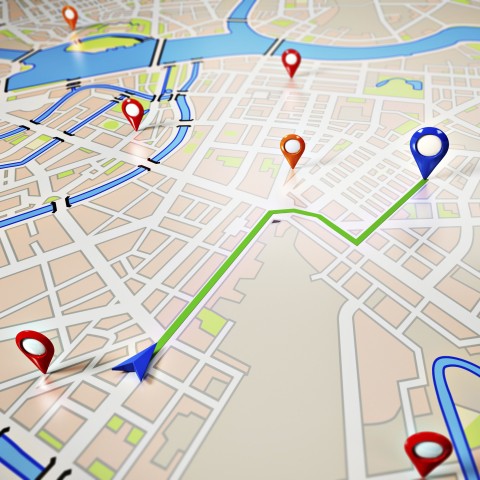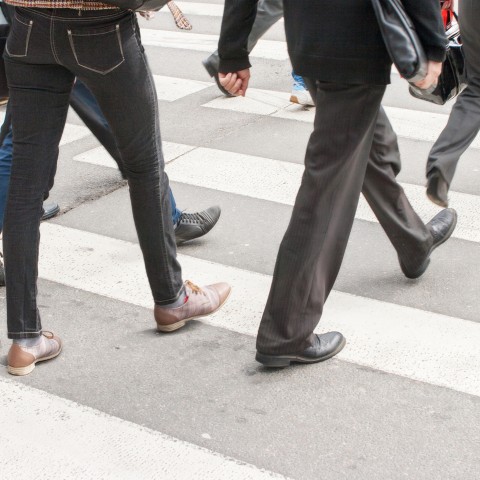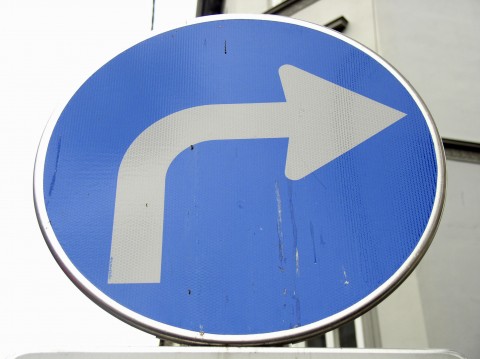
As anyone who has ever traveled knows, getting around without getting lost during your stay abroad is an absolute necessity. Without the proper language elements to ask for and understand directions in Hebrew, it can be quite a challenge to get around without confusion. So whether traveling on foot or by vehicle, in a private or rental car, or by bus or train, it’s essential to arm yourself with some basic vocabulary and grammar so you can get from point A to point B while in unfamiliar territory.
This is as true in Israel as anywhere, and in some ways even truer, considering that a wrong turn could lead you to a security checkpoint you never wanted to go through! So let’s take a look at some of the building blocks for asking for and understanding directions in Hebrew—soon you’ll be cruising the streets of Tel Aviv or Jerusalem with no problem!
Let’s begin by looking at some different situations where we may find ourselves asking for, receiving, or even giving directions. Considering that situations involving directions can often feel rather stressful, involving as they do multiple instructions and unfamiliar names of places, it’s a good idea to take the time to learn about directions in Hebrew and get some practice in before using this language in the real world.
One very effective way to do so is to get ahold of a map of the part of the country you plan to visit, and practice with a partner (or multiple partners), taking turns giving and asking for directions with the map in front of you. Maps of most Israeli cities are available for free online via their municipal websites.
As you’re practicing, remember to think about masculine versus feminine pronouns and verbs depending on whom you’re speaking to. Further consider whether the noun and adjectives you’re using are masculine or feminine.
 Table of Contents
Table of Contents
- Go, Go, Go
- On the Map: Compass Directions in Hebrew
- On the Road
- Landmarks
- Must-know Phrases for Asking for Directions
- Must-know Phrases for Giving Directions
- Putting it Together
- Conclusion
1. Go, Go, Go

The first thing we ought to take note of is that directions in Hebrew, unlike in English, we must choose the correct word for the verb “go,” depending on whether we’re traveling in a vehicle or on foot. ללכת (lalekhet) is the infinitive form of the word “go” if we’re walking. So, for example, if we’re trying to walk to the bus station, we might approach someone and say:
- אני רוצה ללכת לתחנה המרכזית.
Ani rotzeh lalekhet la-tachana ha-merkazit.
“I would like to go [walking] to the bus station.”
On the other hand, if we’re traveling by car, taxi, or public transportation, we would use the verb לנסוע (linsoa), which means “go” by vehicle. To use the previous example, in this case we would say:
- אני רוצה לנסוע לתחנה המרכזית.
Ani rotzeh linsoa la-tachana ha-merkazit.
“I would like to go [by vehicle] to the bus station.”
Another option we could use, which can also be a go-to word in case we can’t remember or aren’t certain how we plan to travel, is to say “get to” or “reach” without specifying the means of travel. This word is להגיע (lihagia). Again, to use the same example, we would say:
- אני רוצה להגיע לתחנה המרכזית.
Ani rotzeh lehagia la-tachana ha-merkazit.
“I would like to get to the bus station.”
The answer to these questions is likely to match the same verb we used in the question. This is because in Hebrew, the verb for “go” depends on how the person is going from point A to point B. For example, if we are trying to get directions for driving to the bus station, we might hear something like:
- אתה נוסע שני קילומטרים לכיוון צפון וזה מצד ימין.
Ata nose’a shney kilometrim lekivun tzafon ve-zeh mitzad yemin.
“You go [driving] two kilometers to the north and it’s on the right-hand side.”
On the other hand, if we were walking, we might hear:
- אתה הולך שני קילומטרים לכיוון צפון וזה מצד ימין.
Ata holekh shney kilometrim lekivun tzafon ve-zeh mitzad yemin.
“You go [walking] two kilometers to the north and it’s on the right-hand side.”
2. On the Map: Compass Directions in Hebrew

Looking at any map, one of the first things we tend to notice is the compass, which indicates the cardinal directions: north, south, east, and west. Of course, we use these directions often to talk about where we’re headed or where we’ve come from.
We’re also likely to use relative directions, which simply express the location of a place relative to other places, landmarks, or our current location. Let’s take a deeper look at how to use these language elements in the context of directions in Hebrew.
Looking at our compass, we have the cardinal directions in Hebrew:
צפון (tzafon) — “north”
דרום (darom) — “south”
מערב (maarav) — “west”
מזרח (mizrach) — “east”
Note that these are all in nominal (noun) form, but we can also use them as adverbs of direction by just adding ה to the end of the words. For example:
סע צפונה עד הרמזור.
Sa tzafonah ad ha-ramzor.
“Go [by vehicle] north until the stoplight.”
Or:
לך מערבה קילומטר וחצי.
Lekh ma’aravah kilometer va-chetzi.
“Go [walking] west a kilometer and a half.”
Cardinal directions can also be used to describe the general location of something. For example:
הטיילת נמצאת בחלק המזרחי של העיר.
Ha-teyelet nimzyt ba-chelek ha-mizrachi shel ha-ir.
“The boardwalk is located in the eastern part of the city.”
אילת נמצאת בדרום ישראל.
Eylat nimzet be-drom Yisrael.
“Eilat is in the south of Israel.”
Notice the importance of the passive verb להימצא (lehimatza), meaning “to be found/located.” In Hebrew, we use this very often to indicate the location of a place, as in the previous example.
In addition to cardinal directions, we often use or hear relative directions or indications when asking for directions in Hebrew on the street. For example:
סע צפונה שני קילומטרים והתחנה המרכזית מול הקניון.
Sa tzafona shney kilometrim ve-haetachanah ha-merkazit mul ha-kenyon.
“Go north two kilometers, and the bus station is opposite the mall.”
Here are some other relative directions we might encounter or want to use:
ליד (liyad) — “next to”
ההתחנה המרכזית נמצאת ליד הבנק.
Ha-tchanah ha-merkazit nimtset leyad ha-bank.
“The bus station is next to the bank.”
קרוב ל… (karov li…) — “near”
התחנה המרכזית קרובה לפארק.
Hatchanah ha-merkazit krovah la-park.
“The bus station is near the park.”
אחרי (acharey) — “past”
התחנה המרכזית נמצאת אחרי הרמזור.
Ha-tchanah ha-merkazit nimtset acharey haramzor.
“The bus station is past the stoplight.”
מאחורי (meachorey) — “behind”
התחנה המרכזית נמצאת מאחורי המוזיאון.
Ha-tchanah ha-merkazit nimtset me’achorey ha-muzeon.
“The bus station is behind the museum.”
3. On the Road

One of the most common situations in which we’re likely to ask for or give directions in Hebrew is, of course, while on the road. It’s useful to know some of the more common phrases in this context to help us as we try to navigate the highways, streets, and even alleyways of Israel. So let’s take a look at some useful vocabulary and phrases that will help us along the way.
One of the more common things we might hear or say with reference to directions on the road is an indication of how far away something is from where we are or from another point of reference (like a landmark). We might ask, for example:
- מה המרחק מכאן לבאר שבע?
Mah ha-merchak mikan le-Be’er Sheva?
“How far is Beer-Sheva?” [Literally: “What is the distance from here to Beer-Sheva?”]
We could also ask the same question like this:
- מה המרחק מכאן לבאר שבע?
Ma ha-merchak mi-kan le-Be’er Sheva?
“How far is Beer-Sheva?”
Note that in the answer, we omit the words מרחק (merchak) meaning “distance” and רחוק (rachok) meaning “far.” For instance:
- באר שבע נמצאת בערך 20 קילומטרים מכאן.
Be’er Sheva nimtset be-erekh esrim kilometrim mi-kan.
“Beer-Sheva is about twenty kilometers away.”
However, if the answer is more general, you’ll hear or say something like this:
- לא רחוק.
Lo rachok.
“Not far.”
Or:
- רחקה מאוד.
Rchok meod.
“Very far.”
Similarly, we might also get the answer קרובה (krovah) meaning “close” or קרובה מאוד (krovah meod) meaning “very close.”
קרוב and רחוק can also be used to orient us relative to other landmarks. Here are some examples:
- שדה התעופה קרוב לצומת.
Sdeh ha-teufah karov la-tzomet.
“The airport is close to the intersection.”
- תחנת הרכבת לא רחוקה מהסופר.
Tachanat ha-rakevet lo rechokah me-ha-super.
“The train station is not far from the supermarket.”
Below are examples of other common phrases to encounter when giving or getting directions in Hebrew on the road:
לצד ימין של (litzad yemin shel) — “to the right of”
- גן החיות נמצא לצד ימין של הספרייה.
Gan hachayot nimtza litzad yemin shel hasifriyah.
“The zoo is to the right of the library.”
לצד שמאל של (litzad smol shel) — “to the left of”
- משרד הדואר נמצא משמאל לאצטדיון.
Misrad ha-doar nimtsa mi-smol la-itzadiyon.
“The post office is to the left of the stadium.”
מסביב לפינה (misaviv lapinah) — “around the corner”
- אתה נוסע לצומת הבא וחנות הספרים מעבר לפינה.
Atah nose’a latzmoet haba ve-chanut ha-sfarim me-ever la pinah.
“You go [driving] to the next intersection, and the bookstore is around the corner.”
לפני (lifney) — “before”
- אתה עובר שני צמתים והבנק נמצא בדיוק לפני הצומת השלישי.
Atah over shney tzmatim ve-ha-bank nimtsa bediyuk lifney ha-tzomet ha-shlishi.
“You go through two intersections, and the bank is just before the third intersection.”
מאחורי (meachorey) — “behind”
- החניה נמצאת מאחורי דוכן הפירות.
Ha-chanayah nimtset me’achorey duchan ha-peyrot.
“The parking lot is behind the fruit stand.”
אחרי (acharey) — “after/past”
- סע ישר ופנה ימינה בדיוק אחרי שאתה עובר את הכיכר.
Sa yashar u-pneh yeminah bediyuk acharey she-atah over et ha-kikar.
“Go [driving] straight, and turn right just past the rotary.”
Note two things in the last example. First of all, notice the verb for “turn,” which is לפנות (lifnot). This is obviously very important to know in the context of getting around. Also note that, just as with the cardinal directions, we can turn relative directions into adverbs by adding a ה to the end of them. So:
ימין (yamin) meaning “right” becomes ימינה (yeminah) meaning “to the right.”
שמאל (smol) meaning “left” becomes שמאלה (smolah) meaning “to the left.”
We also have:
- קדימה (kadimah) meaning “forward”
- אחורה (achorah) meaning “back”
There are obviously some exceptions to this morphology. The most common one is:
ישר (yashar) meaning “straight.”
4. Landmarks

Among the more important vocabulary for us to know when we set out to learn about directions in Hebrew are words that describe landmarks. Obviously, this is important because landmarks are commonly used as references, especially when speaking with a tourist who’s unlikely to know street names but will readily be able to identify landmarks. We’ve already seen quite a few of these in context:
- תחנה מרכזית (tachanah merkazit) — “bus station”
- תחנת רכבת (tachanat rakevet) — “train station”
- שדה תעופה (sdeh teufah) — “airport”
- פרק (park) — “park”
- בנק (bank) — “bank”
- טיילת (tayelet) — “boardwalk”
- מוזאון (muzeon) — “museum”
- צומת (tzomet) — “intersection”
- חניה (chanayah) — “parking lot”
- רמזור (ramzor) — “traffic light”
- כיכר (kikar) — “rotary”
Now, let’s have a look at some other common landmarks!
מרכז (merkaz) — “downtown” [literally, “center”]
במרכז תמצא הרבה חנויות ומסעדות.
Ba-merkaz timtza harbeh chanuyot ve-mis’adot.
“You’ll find a lot of stores and restaurants in the center.”
מלון (malon) — “hotel”
בשביל להגיע למלון, פנה שמאלה ברמזור והמשך ישר חמש דקות בערך.
Bishil lehagi’a la-malon, pneh smola ba-ramzor ve-hamshekh yashar chamesh dakot be-erekh.
“To get to the hotel, turn left at the light and keep going straight for about five minutes.”
בית חולים (beyt cholim) — “hospital”
בית החולים נמצא מול הבנק.
Beyt ha-cholim nimtza mul ha-bank.
“The hospital is across from the bank.”
תחנת משטרה (tachanat mishtarah) — “police station”
איך אני מגיע לתחנת המשטרה, בבקשה?
Eykh ani magia le-tachanat ha-mistarah, be-vakashah?
“How do I get to the police station, please?”

מעבר חציה (ma’avar chatzayah) — “crosswalk”
בצומת הבא, עבור את מעבר החציה ופנה ימינה.
Batzomet habah, avor et ma’avar ha-chatzayah u-pneh yeminah.
“At the next intersection, cross the crosswalk and turn right.”
קיוסק (kiyosk) — “kiosk”
עדיף שתשאל בקיוסק.
Adif shetishal bakiyosk.
“You’d be better off asking at the kiosk.”
תחנת דלק (tachanat delek) — “gas station”
המוזיאון נמצא בדיוק לפני תחנת הדלק.
Ha-muzeon nimtza bediyuk lifney tachanat ha-delek.
“The museum is just before the gas station.”
תחנת אוטובוס (tachanat otobus) — “bus stop”
להגיע לתחנת האוטובוס הקרובה, לך צפונה כשלוש דקות ואתה תראה אותה ליד הפרק.
Lihagia letachanat haotobus hakrovah, lekh tzafonah kishalosh dakot viataha tireh otah liyad hapark.
“To get to the nearest bus stop, walk north about three minutes and you will see it next to the park.”
שירותים (sheyrutim) — “bathroom”
יש שירותים בבנק.
Yesh sheyrutim ba-bank.
“There is a bathroom in the bank.”
5. Must-know Phrases for Asking for Directions

By now, we’ve built up a pretty good vocabulary for asking for and giving directions in Hebrew. Let’s go a bit further and take a look at some essential expressions when giving or getting directions in Hebrew.
Note that some of the language here will be formal. Even though modern Hebrew isn’t terribly formal, it’s preferable to use it to be polite, particularly since you’ll most likely be talking to strangers. Of course, if this isn’t the case, and you’re asking your friends for directions, you can speak to them in a more familiar tone.
Let’s start with basic phrases for asking directions, with examples to show them in context:
- איך אני מגיע לתל אביב?
Eykh ani magia le-Tel Aviv?
“How do I get to Tel Aviv?”
- איפה השירותים?
Eyfo ha-sheyrutim?
“Where is the bathroom?”
The above examples are obviously quite direct and therefore informal. To make them more formal, we would simply start with סליחה (slichah) meaning “excuse/pardon me,” and then add a phrase before the question to make it indirect and thus more formal and polite. Using the previous two examples, here are two common options:
- סליחה, האם תוכל לומר לי איך אני מגיע לתל אביב?
Slichah, hayim tukhal lomar li eykh ani magia le-Tel Aviv?
“Excuse me, could you tell me how I get to Tel Aviv?”
- סליחה, האם אתה יודע איפה השירותים?
Slichah, hayim atah yode’a eyfo ha-sheyrutim?
“Excuse me, do you know where the bathroom is?”
When we get directions, whether from a friend, family member, or a stranger, it is, of course, considered polite to say thank you. Here are a few ways to do so. Don’t forget to use them, even if you’re in a rush!
- תודה.
Todah.
“Thank you.”
- תודה רבה.
Todah rabah.
“Thank you very much.”
- אני מודה לך על העזרה.
Ani modeh lekha al ha-ezrah.
“I thank you for the help.”
- נחמד מאוד מצידך.
Nechmad meod mitzidkha.
“How nice of you.”
6. Must-know Phrases for Giving Directions
While you may mostly be thinking of asking for directions, don’t be at all surprised if someone ends up asking you for directions and you suddenly find the tables turned. This seems to be a subset of Murphy’s Law! But consider this an extra motivator to really work on your mastery of this language; you can repay the favor someday, and not only be the recipient of directions but also be able to give them yourself!
Here are some essential words and phrases for giving directions in Hebrew and how to use them:
- לך/סע ישר.
Lekh/sa yashar.
“Go [walking/driving] straight.”
- חזור.
Chazor.
“Go back.”
- עשה פרסה.
Aseh parsah.
“Make a U-turn.”
- פנה ימינה/שמאלה.
Pneh yeminah/smolah.
“Turn right/left.”
- המשך.
Hamshekh.
“Continue.”
- עצור.
Atzor.
“Stop.”
- לא תוכל לפספס את זה.
Lo tukhal lefasfes et zeh.
“You can’t miss it.”
7. Putting it Together
Now that you know more vocabulary and basic sentence structures, here’s a more elaborate example of how to give directions in Hebrew:
בשביל להגיע לבית החולים, סע ישר בכביש הראשי לכיוון צפון עד הצומת השלישי. עשה פרסה וחזור לכיוון דרום. פנה ימינה בדיוק לפני הרמזור והמשך שני קילומטרים. עצור בבנק ופנה שם שמאלה. תמשיך עוד חצי קילומטר ובית החולים יהיה מצד ימין. לא תוכל לפספס את זה.
Lihagia liveyt hacholim, sa yashar bakvish harashi likivun tzafon ad hatzomet hashlishi. Aseh parsah vichazor likivun darom. Pneh yeminah bidiyuk lifney haramzor vitamshikh shney kilometrim. Atzor babank upneh sham smolah. Tamshikh od chetzi kilometer vibeyt hacholim yihiyeh mitzad yeminkha. Lo tukhal lifasfes et zeh.
“To get to the hospital, go [driving] straight north on the highway until the third intersection. Make a U-turn and return south. Turn right just before the light, and continue two kilometers. Stop at the bank, and turn left there. Continue another half kilometer, and the hospital will be on your right-hand side. You can’t miss it.”

7. Conclusion
Directions can often feel like one of the more stressful aspects of learning a language. But with a bit of practice, it can actually become a truly gratifying experience to show yourself you’re capable of navigating a new place and finding your way! Israelis are sure to help you out when they see that you’ve taken the time to learn their language, so fear not!
And remember, since Israelis all serve an obligatory two or three years in the military, you’re more than likely to encounter an expert navigator who will surely be able to help you find your way! What’s more, Israelis are extremely proud of their knowledge of the lay of the land, and this will come across in their willingness to explain in detail exactly how to get where you’re going. Just get yourself some maps and a partner and practice these language elements before you go “out in the field” navigating. And, as always, have fun!
Before you head off, let us know in the comments how you feel about asking for and giving directions in Hebrew! More confident, or still a little fuzzy? We look forward to hearing from you, and hope that you’ll continue visiting HebrewPod101.com on your journey to language mastery!










